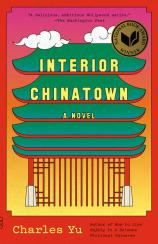Interior Chinatown
Review
Interior Chinatown
Charles Yu is the award-winning author of three books, and has written for shows on FX, AMC and HBO. His fiction and nonfiction have appeared in The New Yorker, the Wall Street Journal and the New York Times, and he was nominated by the Writers Guild of America for his work on HBO’s “Westworld.”
INTERIOR CHINATOWN is part screenplay, part novel, part fiction and part historical reality. At first comedic and satiric, it becomes somber as we are met with a scathing social commentary on immigration and assimilation in the new world for those seeking to start over. This theme subtly underlies the storyline through Yu’s unique lens.
"'Poignant' is a stark and ugly word on the printed page, but beautiful when appropriately applied. INTERIOR CHINATOWN is just that --- a poignant story."
I admit to flipping back and forth in the early, nearly blank pages thinking, What is this, a screenplay? Yes, kind of. This offbeat format appears to have been written on an old IBM Selectric, which in reality it was.* If you are an actor, you may recognize it as such, but soon you will be introduced into the real world of Willis Wu, a generic Asian man who dreams of becoming a Kung Fu Guy like his dad. This is the Asian Bruce Lee ideal, the summit he wishes to conquer in the formulaic world of Hollywood.
I was laughing out loud at Willis’ resume/repertoire as a Generic Asian Man, then wiping a tear from my eye a few pages later when he visits his aging father, the Generic Aging Asian Man. Sifu, once Kung Fu Master Double Dragon, lives in an apartment building in the SRO housing project where many Asian bit-part actors reside. (For the uninformed like me, SRO means Single Room Occupancy --- a form of housing for low-income residents. Thank you, Google). I thought it stood for Standing Room Only, which in reality might better describe the humble living conditions.
The story opens on the interior of a Hollywood set in the old Golden Palace Chinese restaurant beneath their SRO in Chinatown where a popular TV cop show, “Chinatown,” is filmed. The main stars are a well-built, muscular black cop and his sexy, white female partner. There is always a murder in “Chinatown” and a not-so-subtle sexual tension between the leads. Willis has landed a coveted part as an Asian-man-in-the-background-making-a-weird face, a step up from just Asian-man-in-the-background and far better than Asian-man-dead-body. The cops are studying the aforementioned Asian-man-dead-body (an entry-level Asian actor who is just glad to get the gig) as we enter the scene. Willis has hopes of getting a line, but has been told to polish his Asian accent as he speaks perfect English. He aspires to catch that magical light in the right camera shot, or demonstrate his Kung Fu skills to catapult to fame. However, he needs to work on that accent.
Born, raised and educated in America, Willis has assimilated well, but his real life is akin to a role he must continue to play. Unlike his brother, who has gone on to become a lawyer, Willis remains firmly cast as a Generic Asian Man. We follow him through marriage and fatherhood, perhaps ascending to Kung Fu Guy. But is that enough?
“Poignant” is a stark and ugly word on the printed page, but beautiful when appropriately applied. INTERIOR CHINATOWN is just that --- a poignant story. It embraces the austerity of the life of immigrants in Chinatown, or the hundreds of other places in America where people of all ages and ethnicity arrive, full of hope. Their dreams of making a new life have their own stark but beautiful promise.
*If you turn to that obscure page at the very end entitled “A Note on the Type.” (We nerds actually read that stuff.)
Reviewed by Roz Shea on February 7, 2020
Interior Chinatown
- Publication Date: November 17, 2020
- Genres: Fiction
- Paperback: 288 pages
- Publisher: Vintage
- ISBN-10: 0307948471
- ISBN-13: 9780307948472




